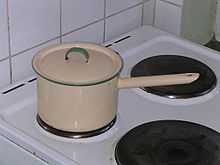Saucepan


A saucepan is one of the basic forms of cookware, in the form of a round cooking vessel, typically 3.5 to 4 inches (90 to 100 mm) deep, and wide enough to hold at least 1 US quart (33 imp fl oz; 950 ml) of water, with sizes typically ranging up to 4 US quarts (130 imp fl oz; 3.8 L),[1] and having a long handle protruding from the vessel. The saucepan can be differentiated from the saucepot by the fact that "a saucepan is a cooking utensil with one handle; a saucepot is equipped with two side handles".[2] Unlike cooking pans, a saucepan is usually not engineered to have non-stick surface. This is so that it can be used in deglazing, a process by which food stuck to the surface of the pan from cooking is recooked with liquid and other ingredients to form a sauce.
History
[edit]A predecessor of the saucepan, preceding the wider use of metal cookware in the late Middle Ages, was the pipkin,[3] an earthenware cooking pot used for cooking over direct heat from coals or a wood fire. They were not held in direct flame which would crack the ceramic. It has a handle and many (though not all) examples had three feet. Late medieval and post-medieval pipkins had a hollow handle into which a stick might be inserted for manipulation. Examples exist unglazed, fully glazed, and glazed only on the interior. While often spheroidal, they were made with straight outwardly-sloping sides.[4] In early modern Europe, saucepans "had small iron trivets, or stands, so that they could be pushed into the hot ashes" for cooking.[5]
Terminology
[edit]In French, the saucepan is called a "casserole", which may lead to confusion. As one cookbook explains:
Casserole: Although this word has come to mean, in English, an earthenware or other oven dish in which foods are 'casseroled,' in France a casserole is simply what we call a saucepan, with high straight sides and a handle. Technically, this kind of saucepan is called a 'casserole russe'; a shallow saucepan with straight sides is a sautoir, a sauteuse, a casserole á sauter, a casserole-sauteuse, or a plat á sauter.[6]
In some households, saucepans are called "pots", in contrast with wider forms of pans, although this confuses them with the traditional cooking pot.[7] Historically, a pot can be broadly defined as "any closed vessel manufactured for use in the cooking process",[8] but in modern usage, a pot may typically be contrasted to a frying pan, compared to which a pot "is a deep vessel with a relatively heavy bottom and a lid.[9]
References
[edit]- ^ Susan Westmoreland, Step by Step Cookbook: More Than 1,000 Recipes (2008), p. 10.
- ^ Louise Jenison Peet, Mary S. Pickett, and Mildred G. Arnold, Household Equipment (1979), p. 120.
- ^ Andrew F. Smith, ed., The Oxford Companion to American Food and Drink (2007), p. 500.
- ^ "Pipkin, Place of origin: England (made) Hampshire (possibly, made) Date: ca. 1500-1600 (made)". V&A. Victoria & Albert Museum, London. Retrieved 19 February 2017.
- ^ Marjorie Quennell, A History of Everyday Things in England: 1500-1799 (1920), p. 180.
- ^ Elizabeth David, French Provincial Cooking (1962), p. 59.
- ^ Sarah Marshall, Preservation Pantry: Modern Canning From Root to Top & Stem to Core (2007), p. 27: "A proper stove station needs good pots, called saucepans here. Saucepans are tall and wide and generally fitted with a lid".
- ^ Jeffrey A. Blakely, W. J. Bennett, Lawrence E. Toombs, Tell El-Hesi: The Persian Period (stratum V) (1980), p. 203.
- ^ Colman Andrews, Country Cooking of Italy (2012), p. 13.
